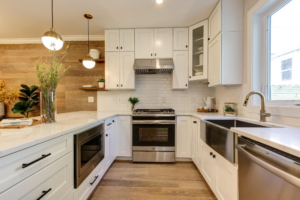Commercial Plumbing Aurora in residential homes keeps the industry going. But commercial plumbing is a whole other animal.
Buildings like hotels, hospitals, and offices use more toilets, sinks, urinals, and faucets than residences. This means their plumbing systems are more complex and require higher-grade fixtures to withstand daily usage. This also means more potential issues.

Plumbing systems in large commercial buildings require more extensive networks than those found in residential structures. These larger systems can support more occupants, require higher water usage, and demand more frequent monitoring and maintenance. A wide range of environmental and regulatory compliance standards may also impact them. The ability to respond quickly and effectively to these challenges requires vigilance and forward-thinking management.
Leaks are a common issue in commercial buildings, and they can significantly impact the functionality of pipes and fixtures. Detecting and repairing leaks quickly is key to maintaining plumbing efficiency and reducing repair costs. Water conservation strategies, such as using low-flow fixtures and educating occupants about water usage, can also help reduce waste.
While clogged drains are a common issue in both residential and commercial properties, they can be more severe in commercial settings. Larger numbers of people and the varying types of materials that are flushed down toilets, sinks, and kitchenettes can lead to more frequent and intense blockages. In addition, clogged drains can impact a wider area of the building and often require more rigorous solutions like hydrojetting to resolve.
Another major challenge that commercial plumbers face is addressing sewer line backups. These issues are often caused by non-flushable items or tree roots and can result in foul odors and even sewage leaks within the property. Managing these issues often requires extensive excavation and repair work that can be disruptive to business operations.
In some cases, it may be necessary to repipe the entire plumbing system in a commercial building. This can be challenging, as many of these pipes are located behind walls or in ceilings, making accessing them difficult. During this process, it’s important for the plumber to coordinate with the building occupants to minimize disruptions and ensure that the business can continue operating. This might involve working during off-hours or rerouting the plumbing in phases so that some areas can remain operational while others are under construction.
It’s also essential for commercial plumbers to keep abreast of the latest advancements in plumbing technology. For example, greywater systems are gaining traction in many commercial buildings as a sustainable water management solution. These systems recycle wastewater from restrooms, kitchens, and laundry rooms for use in toilet flushing, landscape irrigation, or cooling tower make-up water.
Higher Number of Occupants
There are a lot more occupants in commercial buildings than there are in residential homes, so this means the plumbing systems will be used by more people on a daily basis. This increased usage can lead to higher wear and tear on the pipes and fixtures, as well as an increase in the risk of leaks and blockages.
To manage the higher water usage, commercial plumbing systems often have larger pipes installed. They also use industrial-level components like backflow preventers and large water heaters that can handle high-volume waste streams. In addition, commercial locations may need specialized fixtures that can handle the specific types of waste they produce, such as drains for restaurants or water purification systems in hospitals.
Commercial plumbing is also required to comply with strict health and safety standards. This includes ensuring proper sanitation for occupants and preventing the spread of disease. These standards can affect the type of plumbing fixtures and materials that are used, as well as how they’re installed and maintained. It’s essential for commercial plumbers to understand these requirements so they can provide the appropriate services and keep occupants safe.
The plumbing systems in commercial spaces must also be prepared for more extreme weather conditions. This can include insulating pipes in colder areas, installing heat tracing on exposed pipes, and ensuring freeze-proof hose bibs are in place. In addition, commercial plumbing must accommodate emergency situations that can occur due to power outages or water main breaks. This requires rapid responses to minimize disruptions and mitigate damage caused by the outage.
In many ways, commercial plumbing is more complex than residential plumbing. This is largely because of the size and scope of most commercial buildings, such as shopping centers or hospitality suites. They typically have numerous floors with a huge number of sinks, toilets, and other plumbing facilities that need to be serviced regularly. This means that there are a lot more potential points of failure, so it’s important for commercial plumbing to be performed by a professional and experienced team.
More Complex Structure
The plumbing systems in commercial establishments are generally more intricate than those in residential buildings. This is because they are designed to cater to the needs of many different people and handle higher water usage than residential setups. For example, a single commercial building might have hundreds of people using its sinks, toilets, and drinking fountains on a daily basis, while a typical residential house only has a few inhabitants. This increased usage puts a lot of strain on the plumbing system, and it is imperative that it be designed with safety in mind. This involves ensuring that water temperatures are not too high or too low, preventing the release of harmful chemicals, and complying with various building codes and regulations.
In addition to these concerns, commercial plumbing deals with a wider range of pipes and fixtures than those in residential buildings. This includes things like backflow preventers, industrial-level water heaters, and specialized fixtures for restaurants or hospitals. The sheer number of pipes in a commercial structure can also make it more difficult to diagnose and fix problems. A clogged drain in one room might affect multiple others, and it is important to be able to trace the source of the problem quickly.
Another factor that makes commercial plumbing more complex is that it often involves multiple stories. A typical home is usually spread out across a single level or two, but a commercial building might have several floors with their own sets of bathrooms and kitchens. This means that a plumber must be able to work on different levels of the building and consider how gravity affects the flow of water throughout the system.
In addition, commercial plumbing requires more frequent inspections and maintenance than residential plumbing. This is because commercial structures are typically used more frequently than residential properties, which leads to faster wear and tear. It is also more difficult to spot problems in large buildings, and a small issue can quickly become a major one that disrupts business activities or even puts employees and customers at risk. As a result, it is important for commercial plumbers to have extensive training and experience in handling these complex systems.
More Repetitive Work
If a commercial plumbing job is done correctly, it should be durable enough to last for a long time. However, like all plumbing systems, it is still prone to damages and issues over time. As a result, commercial plumbers will likely face more frequent repairs and maintenance than those working on residential properties.
This is due to the fact that commercial spaces are used daily, meaning they have a higher demand on their plumbing systems. In addition, the plumbing fixtures are typically bigger and more complex, requiring more care to keep them in good condition.
As a result, many of the same tasks may be repeated over and over again in a commercial setting, such as unclogging drains or fixing toilets. This can be a turnoff for some plumbers who prefer to have more variety in their work.
Additionally, some commercial jobs require specialized tools and equipment that aren’t available in the standard toolkit of a residential plumber. This includes large pipes, industrial water heaters, and even specialized drainage systems for factory equipment. This is why it’s important to find a commercial plumber who has experience in the type of work you need.
Another aspect of commercial plumbing that makes it more challenging is the time constraints. Since the spaces are open to the public, they can’t be closed for lengthy periods of time as would be the case in a residential home. This means that plumbing operations need to be completed quickly and efficiently.
Fortunately, most commercial plumbing companies will only send their most experienced technicians for each job. This can make the difference between a fast and efficient job, or one that drags on for days.
Finally, as mentioned above, commercial plumbing is generally more expensive than residential. This is because of the bigger and more complex nature of the plumbing systems, as well as the extra wear and tear that comes from having a system in use all day, every day. However, there are still some great plumbers out there who offer competitive rates for their services. Just make sure you do your research to ensure you’re getting the best deal.


